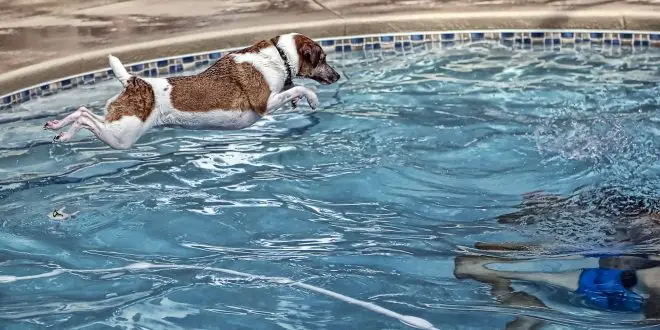As the days get shorter and the temperature slowly starts to drop, it’s starting to get too cold to swim but luckily our southern hemisphere friends are approaching summer and are looking forward spending time next to the backyard swimming pools.
As we’re preparing our coats and waterproof boots, we’d like to remind those lucky ones on few tips and rules that you should consider before letting your beloved pet into the pool.
Before all the fun can begin in earnest you must first get your dog accustomed to the pool and specific rules that are associated with it. It’s not unusual for dogs (especially older ones) to fall in the water and start panicking because of the shock which can lead to injury (of themselves and others).
1. Keep a watchful eye on your pet
The first and the most important rule is to keep an eye on your beloved puppy (and I mean puppies of all ages) at all times and come to their aid as quickly as possible if you notice anything suspicious. Beware not to put yourself in any danger in the process because you will not be able to help anybody if you yourself are in need of saving.
2. Train your dog
If you prepare your dog well and he is familiar with the environment of the pool you will lower the risk of injury and death significantly. Start by slowly introducing your dog to the pool first by showing him where he can enter and exit the pool – don’t let your dog in a pool that has no steps for entry! Our furry friends can’t climb ladders, or simply jump out from the pool – they must have a nice entrance that they can traverse themselves at all times!
Always use positive reinforcement – plenty of treats will result in your dog associating that part of the pool with food, fun and safety. You should also consider placing a large vase or a potted plant next to the pool stairs – it will serve as a visual cue for your pet in case they get disoriented.
3. Use dog life jacket
We all heard that all dogs know how to swim, but you shouldn’t be overly confident about it and push your dog to the deepest part of the pool immediately. Surely, they all start to paddle as they get into the water, but they can get tired easily, get scared or anything else that can lead to disorientation and panic.
That’s why it’s really smart to use a dog specific life jacket. Great example of a life jacket is Ruffwear – K-9 Float Coat – durable, easy to put on a dog, designed to keep your dog in his natural swimming position without restraining him.
4. Give them swimming lessons
Even if your dog isn’t fond of water, and is reluctant to enter the pool you should nonetheless train him in the case they fall in. You must be patient and provide encouragement and safety for your dog. Don’t push them to far from their comfort zone – they must learn gradually at their own pace, otherwise your efforts will be in vain and you will just succeed in reinforcing their fears.
Once in the water your pet should dog-paddle using all four legs. If he/she uses only their front legs for swimming (the obvious sign is a lot of splashing) they waste a lot of energy going nowhere. In that case you should teach your dog how to swim properly.
Don’t worry, it’s no big deal. Gently support their hind legs closer to the surface by holding them under the belly and they should pick up what they have to do instinctively. Another great way is to use a life jacket for dogs, it’ll support them in the water and is a great way to reduce the risk of drowning if the dog gets to tired for swimming.
5. Risk of injury
You should be extra careful that your dog isn’t in the sun for too long. Although he is swimming in the water that is somewhat cooling him, he is still straining himself much more than on land and can easily dehydrate or get a heat stroke. No matter how much our pets enjoy the water we should always take care of their well being – too much of a good thing can be harmful in the end.
Another thing to look out for is your dog’s paws. The area around the pool that is usually done in hard concrete or stone can get extremely hot under the sun and hurt the soles of your pet’s feet. Not only that but your furry friend could damage his/hers nails scraping them on the sides of the pool or jumping in.
Floating pool covers can be dangerous – if your dog, or another human being falls in while the cover is still on it could lead to disorientation and ultimately have fatal consequences. Thankfully there are many different types of safety pool covers on the market today so you should think about installing one for your pool.
Always keep your pet first aid kit ready somewhere handy at all times and don’t let your dog talk you (bark you) into entering a pool, lake, river, sea or any other body of water that you haven’t thoroughly checked for hidden obstructions and dangers. Only when you are sure that the water and the access points are safe to traverse should you let your furry friends enjoy themselves.
6. Risk of water intoxication
It’s all fun and games until someone gets hurt. And it can happen easier than you think. When a dog ingests more water than normal, he can get water intoxication, his bodily fluids get diluted and potentially deadly hyponatremia (low sodium levels) can occur.
It usually happens to dogs that fetch balls or sticks from water, jump in the water and dive to get their toy out, or even from too much hose playing. Symptoms include bloating, nausea, vomiting, excessive salvation, loss of coordination, lethargy, loss of consciousness, coma and death.
To prevent water intoxication you must monitor your dog around water all the time. If he’s fetching and swimming around with an object in his mouth, watch how he’s doing it and if water is entering his mouth all the time and make frequent rests.
7. Establish some boundaries
There might be times when you don’t want to let your dog get in the pool, in that case it’s best that they are not in the vicinity of the pool area, or at least that the pool isn’t in their field of view. It’s also good to give them their favorite toy to play with and take their minds away from the water.
Training comes in handy too – one person should be having a fun time in the pool while the other is doing some training exercises with your pet at the same time by the pool – don’t forget to reward them with plenty of treats for their good pool side manners.
Keeping a watchful eye, training and working with your dog on a regular basis can mean a difference between life and death in the water. If you are careful and make a small effort you and your pets will be much safer and happier in and around water. Remember, all it takes is just that one time that could change your lives forever.
Let’s make sure that our time by the pool is fun and relaxed and without having to worry every step of the way.
 Happy Jack Russell Everything about Jack Russell Terriers
Happy Jack Russell Everything about Jack Russell Terriers





Thanks a ton for sharing such a useful tip, particularly since I was searching for thoughts on this subject last Saturday. Here, you mentioned some valid points exceptionally well. I will certainly dig it and personally suggest to my friends. I’m sure they’ll be benefited from this website.
Hi Amelie, thank you for your kind words and recommendation. Cheers, Ana